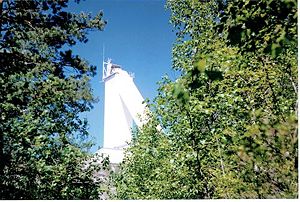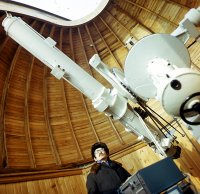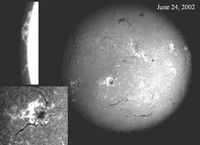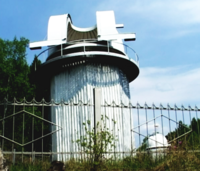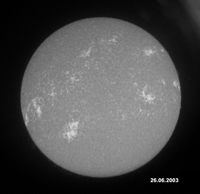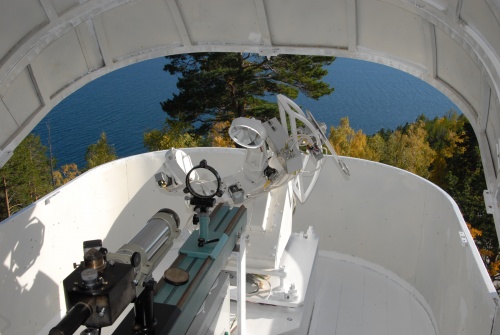Institute of Solar-Terrestrial Physics of Siberian Branch of Russian Academy of Sciences (ISTP SB RAS)
The Baikal Astrophysical Observatory (BAO)
From ISTP SB RAS
|
The Baikal Astrophysical Observatory (BAO) located in the Settlement of Listvyanka (104°53'30 E, 51°50'47 N), on the southwest shore of Lake Baikal, 70 km from Irkutsk, occupies 51.06 hectares. A large water area of the lake, the existence of a local anticyclonic zone and geographical features of the region enable long periods of the stable quality for images during daytime, particularly in separate seasons. Mission:
Telescopes:
|
Contents |
[edit] Large Solar Vacuum Telescope (LSVT)
|
The LSVT is among the top ten largest solar telescopes in the world. It is also on the List of Unique Facilities in the Russian Federation (No. 01-29). USSR AS Correspondent-Member V.E. Stepanov put forward the idea of building such an instrument at Baikal. The telescope has unique optical characteristics enabling to observe fine-structure formations on the Sun at high quality, to study physical processes in the solar atmosphere at high spatial, spectral, and temporal resolutions. |
|
Specifications:
|
|
The telescope catadioptric optical system involves a polar 1-m siderostat, two-lens achromatic 0.76-m objective with a 40-m focal length, and a spectrograph. A slant 40-m telescope pipe is within a metal airproof body closed from above and from below by transparent plane-parallel plates. To eliminate air density fluctuation effects on the image quality, there is a special facility enabling to vacuumize the telescope, by reducing pressure inside the pipe to several millimeters of mercury. The LSVT is equipped with a highly-dispersive spectrograph that facilitates to determine physical properties of the solar plasma (travel velocity, chemical composition, magnetic field), as well as to estimate the temperature, microturbulence velocity, and electron density. |
|
Spectrograph specifications:
The spectrograph optical train represents the Ebert-Fastie system with a 15-m focal length. There are two camera mirrors in the spectrograph, which enables to simultaneously record various regions of the solar spectrum. To obtain polarization spectra and calculate the Stokes parameters, the spectral slit is supplied with a rhombohedron and phase plates. Thereby, in the camera section of the spectrograph, four spectra are formed: two spectral regions in different polarizations. Recording the spectra is done by a FLIGrab wide-format (2048×2048 px) CCD-camera. Simultaneously with the spectra, one records the Sun in the Нα in the light reflected from the spectrograph mirror slit with a narrow-band (5 nm) interference-polarization filter and a (512x512 px) Princeton Instruments CCD-camera. |
|
The actual spatial resolution within the telescope-spectrograph suite reaches 0,4". Recently, a team of researchers and enginneers have been upgrading the LSVT, developing an adaptive optics system to improve the image quality. |
[edit] Main results
The LSVT main observational objects are solar flares. As per the present-day views, at the coronal flare onset, there is an energy release, and then one records chromosphere heating. The heating mechanism related to the flare origin is one of the most compelling scientific challenges. The energy transport from the corona into the chromosphere is possible due to thermal conductivity, X-rays, as well as via beams of charged particles. Although there is no uniform theory for flare formation, the latter mechanism has dominated lately. There are observations exhibiting a good spatial coincidence between X-ray sources and the position of solar-flare emissive cells in the chromosphere. One may elucidate X-rays through electron and proton deceleration in the dense chromospheric layers. Once assumed that beams of particles impinge on the chromosphere radially, the maximal polarization should be observed for the flares that are on the Sun limb, i.e., the spectral line polarization degree should depend on the flare position within the solar disk. The main investigations with the LSVT aim to study the above processes.
Based on observing a great number of solar flares, proven was the existence of shock linear polarization in some solar flares. The difference in the Stokes parameter profiles at various flare regions enabled to estimate the type and energy of energetic particles participating in chromosphere heating, as well as the particle beam penetration depth into the chromospheric layers. These results evidence that, during solar flares, energetic particle fluxes transport energy from the corona into the chromosphere.
[edit] Full Disk Нα Telescope
|
The telescope was designed and made at the ISTP SB RAS in 1980, as per a genuine optical scheme. The instrument was mounted in a stationary tower with a 5-m dome at the 12-m height 150 m from the Baikal shore (75 m above the lake level). Specifications:
|
|
In the telecentric ray path, there is an Нα (656.3 nm) Bernhard Halle Nachfl. GmbH interferential and polarization filter with a 0.05-nm half-width of the bandwidth and with a ±0.1 nm shift. Due to the genuine optical scheme, the telescope (as per the main characteristics) does not yield to the American Lockheed Telescope and outperforms the German Opton. Until 2000, the telescope used an 80-mm film camera. In 2000-2002, a 2048x2048 Princeton Instruments CCD-matrix detector was used in observations. Since 2008, the full-disk chromospheric telescope has been equipped with a C9300-124 Hamamatsu CCD camera with a 2760×4000 detector. The observational archive on films and in e-form is stored at the ISTP SB RAS. |
|
High-angular full-disk observations (including those of over-the-limb structures) enabled to state the following scientific goals:
|
[edit] Main results
- 1. In 1981, started were investigations into activity complexes (ACs) at chromospheric and photospheric levels. Strong quasivertical magnetic fields (floccule and spot) were shown to prevail in the AC central part, where there are active regions including one or several sunspot groups. The CA central part is encompassed by a belt of the quasihorizontal magnetic fields located radially relative to the central part, which indicates an activity complex similarity to the sunspot structure. By using the method based on analyzing synoptic maps for sunspot activity in each Carrington Rotation (in Carrington heliocentric co-ordinates and in the rectangular projection) detected were the sites, where one observed sunspot activity over no less than three solar rotations. Those sites were termed AC nuclei. Such an approach enabled to detect a new important manifestation of solar activity, and also to study its phenomenology, evolution features, spatial and temporal characteristics. Switching from traditional study of active region complexes to the AC ideology that addresses, first of all, long-term evolution of the activity foci (non-shiftable in the Carrington coordinate system) manifesring themselves in multi-monthly AC nuclei evolution enabled to establish a number of relevant regularities in the evolution of geoeffective structures on the Sun. It was possible to show that AC nuclei rotate like solid bodies at a velocity characteristic of ~15º latitudes (Carrington rotation velocity). It is ACs, where as many as 95% of the most powerful flares on the Sun are observed, and this conclusion appeared relevant in studying the issue of solar flares. A number of studies enabled to develop the concept of ACs as the main geoeffective flare-dangerous structures. Besides flares, ACs were revealed to be genetically related to low-latitude coronal holes that form near ACs and in their sites upon decay. Thereby, geoeffective fluxes of high-velocity solar wind (streaming out of low-latitude coronal holes) were shown to be closely - although indirectly - related to ACs. Studying the AC statistics, evolutionary features, and dynamics became a relevant element for the BAO observational program. It is supposed to study powerful solar flares, both for improvement of the flare mechanism, and for a long-term prediction of flares. AC monitoring was deployed, a continuously replenished catalog was created.
- 2. The observational archives at the BAO chromospheric telescope contains a significant number of various-power flares at a high image quality. This enabled to do a series of investigations into the chromospheric flare phenomenology. There is a detailed description for the sequence of variations in the chromosphere fine structure before strong flares and during the latter. Activations of the fine structure and brightenings located far from the flare region (and even in the other hemisphere) enabled to detect those variations and to reveal a special role of boundary lines between magnetic polarities in the evolution and propagation of flaring activations. Marked was a relevant role of convective structures in forming and evolving flare ribbons.
- 3. A high angular resolution of the telescope enabled to successfully investigate the structure and evolution of the most numerous, but yet poorly-studied optical S flares (area under 2 sq.deg) composing 90% of all the flares on the Sun. A goal was set: to try to realise the flaring process evolution in its pure (relatively simple) manifestation. As a result, such flaring processes were established to occur at the boundaries between the chromospheric and supergranular nets, where one observes an increase in magnetic fields, as well as in emission and other processes. In terms of the evolution features, low-power flares do not differ from major solar flares. They emerge (as well as powerful flares) on the magnetic polarity inversion lines of the longitudinal magnetic field, have the explosive phase, are accompanied by activations and by filament disappearance, feature mutiple bursts of intensity, various-power X-ray emission (including X-class), and also proton fluxes. Among them, there are flares covering sunspot umbrae, two-ribbon, and white flares. The flares tend to group temporally into series and spatially - into flaring activity centres, whose lifetime may reach to four solar rotations. Major optical 2-4 class flares usually occur against a weak activity of minor flares (МFs) or in their absence. On average, 7.8 hr prior to a major flare, МВs cease and may resume not earlier than 6.7 hr after its onset. Herewith, ribbons of major flares evolve in the regions, where there were no МFs or their number was negligible, which causes accumulation of free magnetic energy sufficient for the emergence of a powerful flare. Studying MFs obtained a new impulse in investigating the flares emerging far from sunspots in quiet chromosphere regions. Extraspot flares were established to be accompanied by large-scale chromospheric activations substantially surpassing active regions in size. The magnetic field topology plays the determining role in their evolution. Flaring nodes, as a rule, emerge at the boundaries of the magnetic net in immediate proximity from >80-G magnetic hills, where there were significant magnetic field variations. Extraspot flare ribbons may emerge at a significant distance from the magnetic polarity inversion line. Also, one may not observe separation of ribbons. Based on the analysis of the chromospheric data, proposed was (for the first time) an empirical model elucidating the main stages of the extraspot flare evolution. As a result of studies, there appeared a new interpretation for the MF role in the total solar activity structure. MFs were proven to be not random (background) events on the Sun: they may be addressed as indicators for variations in the magnetic conditions on the Sun, indicating the sites subject to magnetic field disturbances.
- 4. Through the 2D tomography, obtained was frequency curve of chromospheric structures on directions in the AR NOAA 9077 area and revealed were intensive rearrangements of those structures' orientation 15-55 min prior to the flare. The investigations were continued by using the device a multifractal analysis device. The existence of the alternated turbulence (multifractal structure) in the chromosphere and the lower corona of active regions was shown. From synchronous observations in the Hα and FeXI 171 Å of the transition region from the chromosphere to the corona, discovered were quasiperiodic (10-20 min) scaling parameter variations correlating with flares. Applying multifractal segmentation to chromospheric images showed that the sites of the singularity index maxima coincide with the flare foci. Further, the same method was applied, for the first time, to detect new magnetic fluxes and flare activity foci by solar photospheric magnetograms.
[edit] Full Disk K Call Telescope
K CaII observations enable to estimate a full magnetic flux, as well as to study the nature of rapid changes in large-scale magnetic fields and the magnetic field fine-structure dynamics in polar regions during the polarity reversal of the Sun general magnetic field.
The telescope was designed and manufactured at the ISTP SB RAS as per the optical scheme similar to that of the Full Disk Нα Telescope. In the telecentric ray path, there is a Bernhard Halle Nachfl. GmbH interferential and polarization filter with the 0.06-nm half-width of the bandwidth.
|
Specifications:
|
The telescope has been in operation since 1995. Until 2003, the image was recorded on the 80-mm film. In 2003, the optical scheme was changed to record images with the 1704×2272 px Sony CyberShot DSC-S85 digital camera.
[edit] New-Generation Solar Telescope for Operative Predictions (STOP-1)
General information on the instrument:
|
[edit] Mission and main measurement characteristics
STOP-1 is intended to receive daily magnetograms of the full solar disk with the 30" angular aperture at the solar photosphere level in quasi-real time, as well as to record the distribution of the Stokes parameters in various spectral lines of the solar photosphere.
Main measurement data:
- program control from the automated system;
- automated data acquisition and processing with displaying the measurement results on computer monitors;
- maximal angular resolution: ~ 30";
- step of the angular resolution adjustment: discrete (6");
- precision of the x, y coordinate measurements: ~2";
- coordinate count method: direct, with feedback (telescope optical axes and the scanning system are rigidly bound;
- accuracy for the binding of the tool coordinate reference system to the heliographic: Sun spin axis direction (~1'), the x, y Sun disk center (2");
- spectrograph dispersion for basic observations in the spectrophotometer green spectral range: ~2.50 Å/mm;
- CCD photometer spatial resolution: ~16 µm;
- CCD photometer dynamic range: 16 bit;
- CCD photometer quantum efficiency for 500-650 nm: ~95%;
- minimal measurement time: ~10 ms;
- maximal measurement accuracy for the polarization degree: ~10-5;
- single magnetogram time: ~15 min.;
- measurement accuracy of the magnetic field in the set point of the Sun image for the 10-s signal accumulation time: ~0.1 G;
- maximal measurement accuracy for the Doppler velocity: ~1 m/s;
- measurement calibration by using different theoretical assumptions, when the initial recorded signals are not subject to distortions
and their values are not distorted by theoretical approximations.
[edit] Instrument structure and specifications of systems
Systems and nodes:
- feeding optics (FO) including the objective and coelostat;
- Littrow spectrograph (LS) including the entrance slit assembly, Littrow objective, diffraction grating, diagonal mirror, and broadband light filters;
- CCD-matrix photometer (CCDP);
- polarized emission analyzer (PEA) including the Glan prism, polaroids, electrooptical crystal, calibration circular nozzle, and half-wave phase plate;
- system of fine guiding and scanning (SFGS), including the CCD-matrix and tracing drives;
- system of control, record, and pre-procession of data (SCRPD), including interfaces, communication and data transmission links, control and power-supply units, microprocessors, personal computer and software, drives;
- telescope pavilion;
- operators' room.
Specifications of subsystems:
- telescope objective: 42-mm refractor with the 500-mm focal length;
- two-channel coelostat 150-mm mirrors;
- autocollimation spectrograph: 200×300-mm 600 gr/mm grating, ~2.50 Å/mm dispersion, 0.05-0.15 mm entrance slit width, 147-mm Littrow lens with the 16-m focal length;
- total number of controlled positioning drives: 10;
- number of channels tracing the Sun: 1;
- power consumption: <1 kW.
[edit] Operation principle
The instrument contains a horizontal solar refractory telescope with the Littrow spectrograph optically conjugate with it. By using this system, one makes the spectrum image in the selected wavelength segment for the set site of the Sun image. Scanning the image and fine guiding is performed with the CCD camera and with the coelostat mirror drives. They displace the image relative to the spectrograph entrance slit and measure its position in the tool's coordinate system. Scanning the image is stepwise by the set law. Simultaneously, the CCD camera records the distribution of spectrum band intensity for each site of the Sun image, as well as the current time and coordinates.
To measure the Stokes parameters, one uses the electrooptical analyzer located behind the spectrograph entrance slit. For each state of the analyzer, one measures the intensity necessary and sufficient to further calculate the Stokes parameters. The tool polarization is accounted for by the phase plates installed in front of the coelostat. Herewith, only the desired signal is modulated, whereas all the tool-originated signals remain invariable, which enables to split the signals into the solar- and tool-origin.
Measuring the magnetic field is based on the Zeeman effect for the photospheric absorption lines. These measurements do not differ methodically from those of the Stokes parameters. The multichannel sensor enables simultaneous observations in several magneto-sensitive lines in the ~4 Å spectral range.
Radial velocities of the Sun substance motion are measured by using different Doppler effect of reference points. One always measures the Doppler velocities at polarization observations in order to improve the data quality.
The system of data control, record, and procession enables to save data, pro-process them, to visualize the measured parameters in quasireal time, as well as to control the telescope in the interactive mode.
[edit] Solar Synoptic Telescope (SOLSYT)
In heliophysics, increasing attention is paid to regular long-term measurements of magnetic fields encompassing the entire solar surface. Only possessing such information, one can (at certain assumptions) calculate the parameters of the heliosphere and to predict geoeffective phenomena. Therefore, researchers pay notable attention to creating the instruments capable of conducting such observations. To reduce Russia's lag in this field (as compared with the advanced countries), a few years ago, the ISTP SB RAS in cooperation with the LOMO PC launched the program to design and manufacture a new instrument: SOLar SYnoptic Telescope (SOLSYT).
The telescope involves two main components: an objective and a spectrograph. The objective is the Mersenne system comprising two off-axis parabolas, and an intermediate slit node with a heat exchanger cooling down to the environment temperature. In the parallel beam (a significant condition for the used electrooptical polarization analyzer, because f-o-v errors are eliminated), there is a rotating rack with the interference filters in front of the apochromatic objective after the secondary mirror and the polarization analyzer.
Main mirror specifications:
| 2.799-m | focal length |
| 0.35-m | entrance pupil |
| 1:8 | relative aperture |
| 35.4' | angular field-of-view |
| 0.5-1.8 µm | spectral range |
| 0.4" | estimated resolving power |
One builds the Sun image on the spectrograph entrance slit by using the apochromat objective, in which chromatism is corrected for the 525, 630, 850, and 1085 nm wavelengths, and aberrations are replenished at the operation with an extended source.
SOLSYT spectrograph parameters at observations in the main operation lines
| Wavelength, Å | Diffraction angle | Diffraction order | Dispersion, Å/mm |
| 5250 | 51.96 | 10 | 0.646 |
| 6300 | 49.12 | 8 | 0.875 |
| 8500 | 49.91 | 6 | 1.404 |
| 10830 | 54.47 | 5 | 1.521 |
- This page has been accessed 15,853 times.


